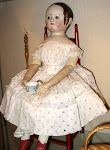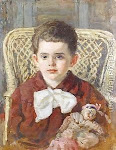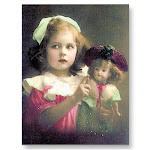Lovely Frozen Charlottes shards
Frozen Charlottes are a type of china doll popular during the late 19th and early 20th centuries. The name came from Fair Charlotte, a well-known American folk ballad attributed to William Lorenzo Carter. It is believed to have been composed some time between 1833 and 1860. He was inspired to write the poem after reading in the New York Observer on Feb 8, 1840... "A young woman... was frozen to death while riding to a ball on Jan 1, 1840."


 The ballad tells the tale of lovely mountain girl who set out in a sleigh with her lover, Charley, to attend a New Year’s dance. Her mother warned her to wrap herself in a blanket to keep warm, but Charlotte ignored her… “No, no, no, fair Charlotte said and she laughed like a gypsy queen. To ride in blankets muffled up, I never can be seen.” The lyrics then tell of Charley as they rode through the frozen night air… “Why sit you there like a monument that has no power to stir? He called her once, he called her twice, she uttered not a word....fair Charlotte was a stiffened corpse and her lips spoke nevermore.”
The ballad tells the tale of lovely mountain girl who set out in a sleigh with her lover, Charley, to attend a New Year’s dance. Her mother warned her to wrap herself in a blanket to keep warm, but Charlotte ignored her… “No, no, no, fair Charlotte said and she laughed like a gypsy queen. To ride in blankets muffled up, I never can be seen.” The lyrics then tell of Charley as they rode through the frozen night air… “Why sit you there like a monument that has no power to stir? He called her once, he called her twice, she uttered not a word....fair Charlotte was a stiffened corpse and her lips spoke nevermore.”

 From my collection: Beautiful Charlotte part of the "Mary Merritt Doll Museum "auction.
From my collection: Beautiful Charlotte part of the "Mary Merritt Doll Museum "auction.
 Of course there was a lesson to be learned from this tragic tale, and many young girls who later played with Frozen Charlottes probably were warned:
Of course there was a lesson to be learned from this tragic tale, and many young girls who later played with Frozen Charlottes probably were warned:
Now, ladies, when you hear of this… Think of that dreadful sight, And never venture so thinly clad, On such a winter's night.

 The dolls depicting Charlotte and Charley, were extremely popular and sold for only pennies this allowed children to accumulate a collection of dolls with which to play. The sad story of their tragedy only heightened the doll’s popularity.
The dolls depicting Charlotte and Charley, were extremely popular and sold for only pennies this allowed children to accumulate a collection of dolls with which to play. The sad story of their tragedy only heightened the doll’s popularity.

 Part of my collection of Frozen Charlottes and half dolls.
Part of my collection of Frozen Charlottes and half dolls.

 Shards found in excavations from factories in Thuringia, Germany.
Shards found in excavations from factories in Thuringia, Germany.
 From my collection: Blond and a dark hair Charlottes with red garters and gold enamel shoes.
From my collection: Blond and a dark hair Charlottes with red garters and gold enamel shoes.
 Very detailed chubby Charlotte with molded bonnet.
Very detailed chubby Charlotte with molded bonnet.  Ideally they could be played with in water, but only if they were made of fine, light, porcelain so they could float. In Germany they were referred to as “Badekinder” (bathing doll) or “Nachtfrosch” (naked baby).
Ideally they could be played with in water, but only if they were made of fine, light, porcelain so they could float. In Germany they were referred to as “Badekinder” (bathing doll) or “Nachtfrosch” (naked baby).
Marks are almost nonexistent on these dolls, but the grounds of the Kister and the Conta Boehme factories in Thuringia, are filled with china shards from these dolls that date from the 1850s, and they range in size from under one inch to 18 inches plus.
 Friendship keepsake
Friendship keepsake
 Tiny Charlotte in velvet frame, ca. 1890
Tiny Charlotte in velvet frame, ca. 1890
 Frozen Charlotte made into a music box.
Frozen Charlotte made into a music box.
 From my collection: Frozen Charlotte with molded dress,and her little sister finished with a pink satin tint, and covered wagon hairstyle .
From my collection: Frozen Charlotte with molded dress,and her little sister finished with a pink satin tint, and covered wagon hairstyle .
 Besides porcelain, the Charlottes are also made in bisque, and can come in white, soft pink or, more rarely, painted black. In rare cases, the Charlottes also come with molded dresses. Male dolls (identified by their boyish hairstyles) are called Frozen Charlie.
Besides porcelain, the Charlottes are also made in bisque, and can come in white, soft pink or, more rarely, painted black. In rare cases, the Charlottes also come with molded dresses. Male dolls (identified by their boyish hairstyles) are called Frozen Charlie.
 From my collection, a trinket box filled with miniature all bisque, and lillyputian Frozen Charlottes including a tiny black one.
From my collection, a trinket box filled with miniature all bisque, and lillyputian Frozen Charlottes including a tiny black one.*************************************************************


 Part of the charm of these dolls lay in the variety of costumes one could fashion for them out of incredibly small scraps of silks, ribbons and laces—veritable scraps from the tables of grown-ups.
Part of the charm of these dolls lay in the variety of costumes one could fashion for them out of incredibly small scraps of silks, ribbons and laces—veritable scraps from the tables of grown-ups.
What a harvest time it was during the visits of the “by-the-day” dressmaker, who came every spring and fall for a week or a fortnight to refurbish the family wardrobes!
How eagerly one watched for, and how gleefully seized upon any sizable scraps that fell from her shining scissors.
 From my collection: Unusually large Frozen Charlotte (over ten inches) dressed in Victorian bathing outfit, and an eleven inches "Charlie".
From my collection: Unusually large Frozen Charlotte (over ten inches) dressed in Victorian bathing outfit, and an eleven inches "Charlie".
These dolls give one pause, and perhaps the answer is that the prudery of the Victorian era was invented for the young ladies, who lived in a world of chaste ignorance. But if one really searches into Victorian times, there was a good deal of nudity present:
In their works of art, the ornaments in the parlor and the china fairings gracing their cottage cupboards.
 The dolls are simple, and geometrical. The limbs and trunk molded, and assembled while the clay was still soft. This method of building was how these large, hollow figures with massive limbs, acquired that solid archaic look that is difficult perhaps to visualize as part of the Victorian nursery.
The dolls are simple, and geometrical. The limbs and trunk molded, and assembled while the clay was still soft. This method of building was how these large, hollow figures with massive limbs, acquired that solid archaic look that is difficult perhaps to visualize as part of the Victorian nursery.













































.jpg)







































































